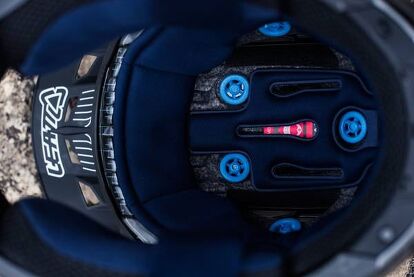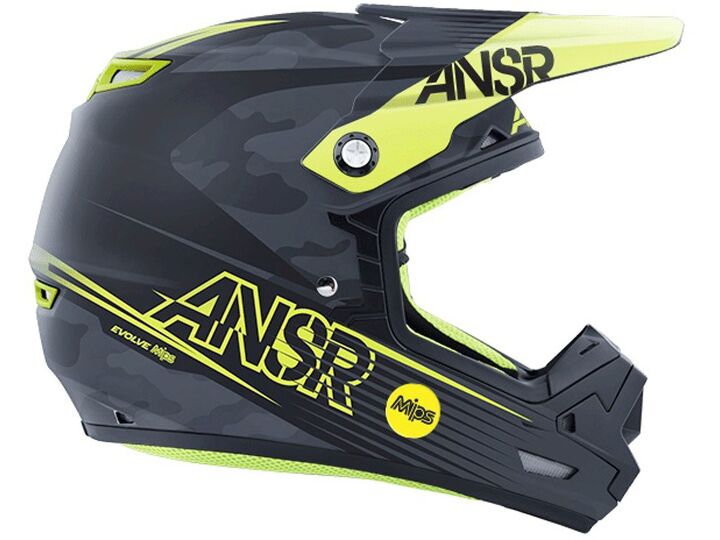Helmet Tech: Reducing Rotational Brain Violence
6D, Leatt and MIPS are all working to better protect your gray matter
If the technologies driving motorcycle components progressed at the same rate as motorcycle helmet technology we’d still be riding around on drum brakes. Where’s the motorcycle helmet equivalent of cutting-edge technologies such TC, C-ABS or semi-active suspension? The general construction of motorcycle helmets hasn’t changed much since leather lids became passé: a hard outer shell, impact-absorbing EPS (expanded polystyrene) liner, comfort padding. Helmets are certainly lighter, quieter, more comfortable and safer than their bygone counterparts, but I would have argued 20 years ago that the features touted by failed helmet company start-up, Skully, would have been commonplace by now.
Sena Unveils Smart Helmet With Noise Control + Video
Make no mistake, helmet manufacturers and the technology companies that support them are dutifully working toward improving helmet functionality, and there has been some recent breakthrough technologies introduced from proprietary helmet companies 6D, and Leatt, as well as MIPS.
MIPS is the acronym for Multi-directional Impact Protection System, a system that reduces rotational forces via deflection technology. Basically, according to MIPS, when a crash occurs, your helmeted head is more likely than not to hit the ground at an angle, creating rotational forces. MIPS provides a thin, low-friction layer inside the helmet allowing for some rotation to occur separate from your skull, thus deflecting the energy in another direction and reducing the impact to your brain. The video below provides a visual representation of MIPS in action deflecting rotational forces.
The difference between MIPS, 6D and Leatt is where 6D’s elastomeric isolation dampers, and Leatt’s Turbine Technology with Armourgel reduce rotational forces and maximize shock absorption, MIPS focuses solely on minimizing rotational forces. Also, whereas 6D’s and Leatt’s technologies are proprietary to their own helmets, MIPS is meant to be adapted to any currently produced helmet regardless of manufacturer. The list of helmet companies now offering MIPS is growing, but right now includes: Answer, Bell, Fly, Fox, MSR, O’Neal, One Industries, and Troy Lee Designs.
Until recently MIPS was confined to bicycle helmets and off-road helmets, however, Bell announced last June that it will be incorporating MIPS into its MX-9 Adventure, and Qualifier DLX street helmets this fall. Bell also says the new Pro Star ($1199.95) and Race Star ($699.95) street helmets utilize a proprietary triple liner – “Flex” system – that replaces the single thick EPS layer. The three-layer system works together to better absorb impacts, as well as provide a reduction in rotational energy. According to AMP Factory’s (owner of Answer, Fly, and Fox) Phil Davy, a streetable helmet utilizing MIPS from an AMP Factory helmet OEM will soon join Bell’s and 6D’s offerings.
Bell Helmets Shows Us Race Star And Pro Star Lids
Like MIPS, 6D helmets were initially available only in off-road models, but as of this year 6D ventured into the street segment with ATS-1 ($895). We recently received an ATS-1 for evaluation, so look for a future review of it, but for now let’s focus on the technology driving the company’s claims of increased safety.
An array of 29 elastomeric isolation dampers situated between the dual EPS liners within 6D helmets are what provides the Omni-Directional Suspension (ODS). The result is a claimed reduction in energy transfer to the brain during low-, medium-, and high-speed impacts for both angular (rotational) and linear (straight-on) varieties.
According to 6D’s website, the ATS-1 is certified to exceed U.S. DOT FMVSS 218, and ECE 22.05 standards, meaning the helmet was able to pass the battery of tests that comprise each organization’s safety standards – both of which focus primarily on linear impacts. Neither of the helmets discussed in this article meet Snell standards, but there’s nothing inherent in their designs that would prevent a manufacturer from constructing a helmet that could achieve Snell’s higher impact thresholds. Currently, there are no standardized testing criteria for determining a pass/fail scenario for angular impacts. Mattias Eidelbrekt, head of sales for MIPS, says the ECE is currently working on incorporating rotational testing into its standardized helmet-testing regiment.
Until DOT and ECE determine what constitutes standardized testing for rotational impacts, we must rely on the claims of the manufacturers and the independent laboratories conducting the testing such as Dynamic Research in Torrance, California.
Recently on MO, in John Burns’ Unsung Heroes article, Dave Thom, senior consultant at Collision and Injury Dynamics, Inc., (and famous within our industry for co-authoring the groundbreaking Hurt Report published in 1981) was quoted as saying, “There are definitely new technologies emerging that will improve helmets and head protection. Dr. Terry Smith worked with Professor Hurt and I at USC and recently presented a paper at an international meeting. All of the ‘anti-rotation’ technologies reduced rotational acceleration on the particular test Terry used. The problem is that there isn’t a standardized test yet and there are no accepted pass/fail criteria, so it’s all somewhat experimental at this point. With that said, I wore my new 6D ATS-1 to work today.”
Best known for its innovative line of neck braces, Leatt has expanded into a wide variety of safety equipment including knee braces, body armor, and, of course, helmets. Leatt currently does not have street helmets in its model lineup, but its motocross helmets offer what it calls 360° Turbine Technology that’s similar to 6D’s Omni-Directional Suspension.
Unlike 6D and its elastomeric isolation dampers situated between the dual EPS liners, Leatt places 11 Turbines between a single EPS liner and a rider’s head. According to Leatt, the Turbines are made of Armourgel, a material that absorbs and dissipates up to a claimed 80% of impact forces. Leat claims that the Armourgel Turbines in its helmets help to reduce the severity of concussion-level head impacts by up to 30%, and rotational acceleration impacts by up to 40%.
If Leatt were to follow 6D’s and Bell’s trend, a streetable helmet would seemingly already be in the works. However, the company tends to focus solely on the off-road market, making a street helmet from Leatt less likely.
Leatt Helmet Range and Tech Features
It seems obvious that helmet manufacturers such as 6D, Bell and Leatt and companies like MIPS are serious about improving the safety of the helmets you and I wear by examining what’s happening within a helmet, as well as inside your head, during a crash, and devising ways to reduce the various types of brain trauma. It’ll be interesting to see how this technology develops, and if/when other mainstream manufacturers (Arai, Shoei) get in on the act.
Now, about those heads-up displays?
A former Motorcycle.com staffer who has gone on to greener pastures, Tom Roderick still can't get the motorcycle bug out of his system. And honestly, we still miss having him around. Tom is now a regular freelance writer and tester for Motorcycle.com when his schedule allows, and his experience, riding ability, writing talent, and quick wit are still a joy to have – even if we don't get to experience it as much as we used to.
More by Tom Roderick




































Comments
Join the conversation
I want this in my next Shoei.
I couldn't be less interested in heads-up displays.
But these ‘anti-rotation’ technologies are welcome improvements.
I hope they find their way into reasonably priced helmets, not just the $1,000 jobs.